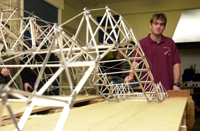

Students have tennis covered

Twelve students from Munich spent a week at the University last month with the lightweight structures unit, developing designs for tennis court covers that could render rain breaks at tennis championships a thing of the past.
The German students put their heads together with eleven architecture students from Duncan of Jordanstone to design weather proof canopies for tennis courts that can quickly and easily be deployed from the ground to prevent courts from sudden downpours.
For seven days the Scottish and German teams combined computer and physical modeling to design prototypes then reduced-scale working models.

The objective was to conceive a light, deployable roof system for tennis courts and athletic field events. The strict requirements of the Lawn Tennis Association and UK Athletics provided a challenging brief.
Studies of existing canopies found that they could only be deployed from the ground using heavy lifting equipment. The students were aiming to design a lighter, safer structure, which can be easily deployed in a much shorter time.
The tutors, Dr Fraser Smith and Neil Burford are founders of the lightweight structures unit - an interdisciplinary research group of engineers and architects involved in the design and application of lightweight and temporary structures. The LSU has specialist computational modeling software, specialist computer controlled membrane plotting/cutting and extensive experimental small and large scale testing facilities and workshops.

As a result of a visit by Fraser Smith and Neil Burford to the Technical University of Munich, in May 1999, the idea developed for a programme of inter-university student workshops in innovative deployable structures.
Last month's student workshop was the second to take place at the University. In February 2000 students investigated the weight-bearing properties of such structures. Their practical results were compared with computer models developed in Munich and during 2001 the two universities developed a design study.
The vision of the LSU and the chair of structural design at TUM is the formulation of design criteria for the practical implementation of hybrid lightweight tension structures for applications in mainstream architectural and engineering design.

Neil Burford said, 'The workshop was a great success and we are working to make these canopies commercially viable.
During the weeklong workshop the design team produced and assembled the components of the structure. The final day of the project saw a practical demonstration of the models in the LSU workshop.
Caption- Students from Munich and Dundee working on their designs in the school of architecture.
Next Page
Return to April 2002 Contact